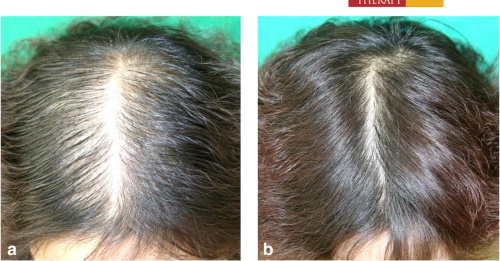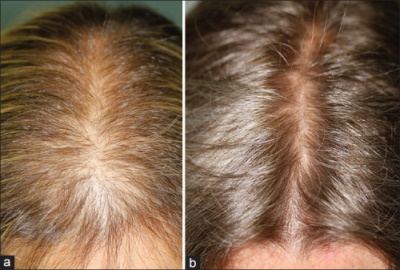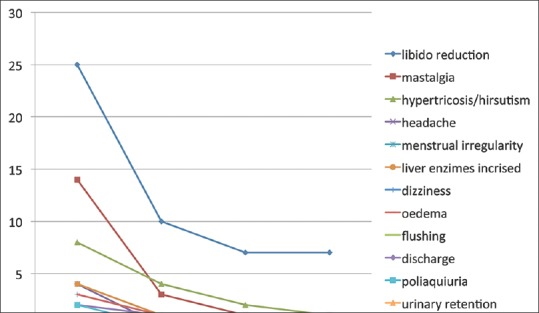Last Updated on July 29, 2020 by Robert Price
Finasteride is slowly becoming a more mainstream option for treating female hair loss.
FDA-approved for men, it’s been helping guys avoid premature baldness since 1997. Over the last few years, many women have used it with great success too.
Finasteride works by blocking the production of a particular androgen, DHT. DHT is a male sex hormone that all women carry at low levels.
It’s known to cause pattern hair loss in men and women who are sensitive to its effects.
In this post, I’ll cover everything you need to know about finasteride, including.
- The reason why it’s still a controversial option in the treatment of female hair loss.
- The studies on finasteride use in women.
- The potential side effects of the medication.
- The contraindications of finasteride and why women with a family history of breast cancer may want to avoid it.
- And more.
The overwhelming majority of finasteride posts on the internet are written for men. This one’s different, focused exclusively on women who are considering or using the drug.
Let’s get into it. Here are the 12 things you should know before you consider or begin a finasteride treatment regimen.
1. It’s a Category X Drug
It’s a drug to avoid completely — meaning don’t even touch it let alone use it — if you’re pregnant or may become pregnant.
Severe birth defects are possible, particularly in male fetuses.
2. It Remains Controversial
Doctor Jeff Donovan, a dermatologist in Canada, notes that finasteride is a controversial medication in the medical community.
Some doctors don’t prescribe it all to women.
Others will only prescribe it to post-menopausal women.
Many recommend it on a case by case basis.
3. 1 MG Dose Was Ineffective in a Study
1 MG is the typical finasteride dose for men.
In an early study, the 1 MG dose was found to be ineffective in treating female hair loss.
Accordingly, for many years, it wasn’t prescribed to women suffering from androgenic alopecia, pattern hair loss.
Then scientists began testing it at higher doses — and that leads me to my next point.
4. 2.5 Milligrams Works Quite Well for Some Women
In a 2006, Italian researchers conducted a finasteride study using a higher dose, 2.5 milligrams per day. 37 patients participated. All of them also took birth control pills containing drospirenone and ethinyl estradiol.
Researchers used global photography to assess each patient’s hair at the study’s conclusion.
After 12 months, these were the results:
- 12 patients displayed slight improvements.
- 8 had moderate improvements.
- 3 saw great results.
- No losses or gains were reported in 12 others.
- 1 person had further thinning during the study.
Overall, 62% saw some degree of improvement.
A second, larger 2006 study showed even better results. It had 112 participants and lasted for 6 months.
Significant improvements were noted in 73 of those patients — over 65%.
33 patients (29.5%) saw slight improvements. No change was reported in the remaining six patients.
Before and After

Source. One patient’s dramatic transformation after only 6 months on finasteride.
5. 5 Milligrams May Work Even Better
Some physicians are now prescribing finasteride at 5 mg per day to their female patients.
In 2013, 40 post-menopausal women participated in an 18-month finasteride study. They took 5 mg daily with no other treatments. Researchers assessed their hair via photos after 6, 12, and 18 months.
At the 6 month mark, they found the following:
- 16 patients showed moderate improvements.
- 16 recorded significant gains.
- 8 had no losses or gains.
The numbers improved slightly with time.
By the study’s conclusion, 20 patients showed significant gains. 16 had slight improvements. The other four saw no significant thinning or thickening.
The drug was well-tolerated overall, per the researchers.
4 patients reported libido reductions. However, they elected to continue the treatment in spite of that side effect.
One patient experienced an increase in their liver enzyme levels. Those levels normalized without her needing to stop the medication.
Before and After Finasteride (5 Milligrams)

One woman’s dramatic transformation after 18 months of consistent finasteride use.
6. It Likely Works Best for Women Under 60
Of 20 women who saw major improvements in the study above, 13 were age 60 or under.
The medication also worked fairly well for women between the ages of 60 and 70.
Only 5 patients over the age of 70 participated. 2 saw no results, positive or negative. 3 showed moderate improvements.
The Italian researchers concluded that older patients responded less favorably to finasteride.
7. Overall, It’s Been Well-Tolerated in Studies
Again, the data is somewhat limited.
But most female users appear to take the drug without any major complaints.
Some even continue using the drug when they experience side effects, due to its benefits outweighing the risks/adverse effects.
Speaking of side effects, the next couple of points will cover some of the most common side effects associated with finasteride.
8. Sexual Side Effects are Most Common
A 2018 report with 236 patients — the largest I’m aware of — focused primarily on the safety of the medication.
After 3 months, 25% of users reported reduced libidos.
That side effect decreased markedly with time.
By the study’s conclusion three years later, only 7 (about 3%) reported libido disturbances.
Headache, Sore Breasts, and Hirsuitism (body hair growth) were a few of the other noteworthy complaints.
In the study above, 25% of patients reported an adverse effect after 3 months.
At the last evaluation, after 3 years on finasteride, the overall side effect rate was just over 3% among the patients.
Below is a adverse effect chart from that study.
9. There’s No Established Finasteride-Breast Cancer Link
Again, according to Jeff Donovan, a dermatologist in Vancouver, there’s no known direct link between finasteride use and breast cancer.
He cites a Prostate Cancer Prevention trial, among others, to validate his claim. That study had over 18,000 male participants and lasted for 7 years.
No increased risk for breast cancer was observed in the finasteride group vs. the placebo (control) group.
10. Often Not Recommended to Women with a Family History of Breast Cancer
Yes, a family history of breast cancer may prevent you from obtaining finasteride.
Research is limited, as I’ve said.
And women at a high risk of developing breast cancer are typically advised against using the medication.
While no direct link between breast cancer and finasteride use has been established, prescribers still proceed with caution when prescribing the medication.
11. There are Alternatives to Finasteride
It’s not a treatment for everyone, especially those who are or who may become pregnant.
A few of the potential alternatives to finasteride include:
1. Spironolactone
Used to treat a wide range of conditions from heart failure to acne, Spironolactone has shown effectiveness as a hair loss medication. It’s a potent anti-androgen — i.e. it helps block the hormone that causes pattern hair loss in women.
2.Birth Control Pills
Another popular option, particularly among younger women, a number of oral contraceptives can help treat hair loss. The brands Yaz and Yazmin were found to be particularly effective, according to the ISHRS (International Society of Hair Restoration Surgeons).
3. Hormonal therapy
Estrogen and progesterone are frequently used to combat female hair loss. This combined treatment approach is sometimes known as hormonal therapy.
12. Supplementary Treatments May Also Help
Particularly in cases of moderate to severe hair loss, a multi-prong approach to treatment may be desired. Here are a few popular, over-the-counter medications for your consideration:
1. Minxodil
It’s usually the first line of attack against female hair loss. Studies have shown in works for 6 in 10 women.
It’s not necessarily an “alternative” to finasteride as it yields less growth overall. But minoxidil is an easy, supplementary treatment to add to your arsenal.
A nice option for women especially.
It works differently than either minoxidil or finasteride and can help recharge your thinning hairs at the cellular level. Compliance can be an issue with this treatment.
It requires consistent use — at least a half hour, three times per week.
3. Ketoconazole
Adding a ketoconazole shampoo to your routine could lead to some gains as well.
An anti-fungal agent, a number of small studies have shown that it’s a low-risk, supplementary treatment option for hair loss, if nothing else.
Finasteride for Female Hair Loss – Conclusion
If you’re experiencing moderate to severe pattern hair loss, finasteride is a treatment that can definitely help. But it comes with risks, particularly if you’re of child-bearing age.
While the data is limited, it’s a medication that has a track record and overall, the research indicates that the drug is well-tolerated in women.
Women under the age of 60 responded best to finasteride. It also worked fairly well for women between the ages of 60 and 70 in the 2013 study I cited above. If you’re over 70, it’s less likely to work as well for you.
Finasteride is undoubtedly one of the 12 most effective treatments for female hair loss at this time. Whether the risks outweigh the benefits of this drug is something you’ll have to think about for yourself, then discuss with a physician if desired.
Robert Price is a writer, consumer advocate, and hair loss researcher with thousands of hours of experience in the field. His goal is to keep you out of the hair loss rabbit hole, underworld, or whatever you want to call it. He founded Hair Loss Daily, the unbiased hair loss blog, in 2016. You can learn more about Robert in the my story section of this website.

